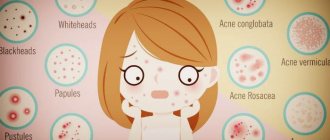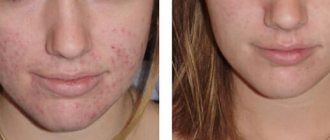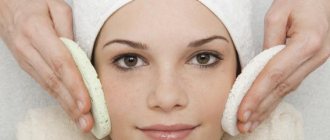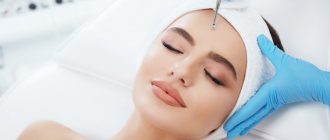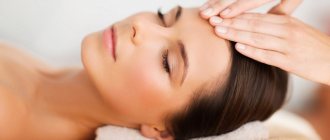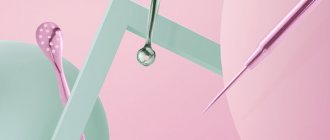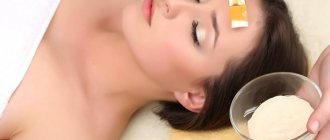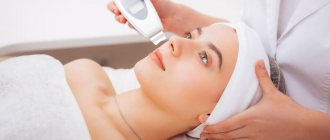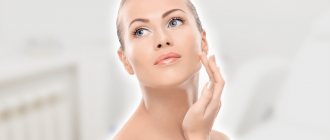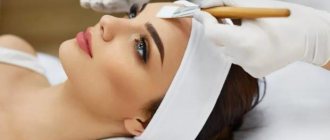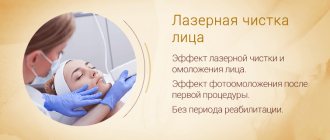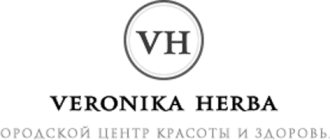The question of how often you need to cleanse your face is one of the most frequently asked. There is no definite answer to this, since much depends on the type and condition of the skin. If it is dirty, black spots, redness and inflammation are noticeable on the surface, more intensive cleansing is required. If the skin looks well-groomed, it still needs to be cleansed, but less often and with more gentle methods. But first things first. Let's look at what methods are used to clean different types of skin and how often they need to be used.
Indications and contraindications
The content of the article
Before you carry out cleaning yourself, you need to make sure that it is really necessary and that there are no contraindications.
It's time to peel if:
- age-related changes have appeared (wrinkles and sagging);
- there are various rashes (acne and pimples);
- I want to get rid of small scars, stretch marks and cicatrices;
- irregularities, pigment spots and roughness appeared;
- complexion has become uneven or sallow.
The procedure is strictly prohibited if:
- the presence of a large number of moles or if there is a birthmark;
- herpes;
- allergic rashes;
- dermatitis;
- eczema;
- tendency to develop scars;
- psoriasis.
It is also not recommended to cleanse the face for those suffering from cardiovascular diseases, epilepsy and bronchial asthma.
Facial cleansing for teenagers
One of the first cosmetic procedures for many boys and girls is facial cleansing.
Teenagers are forced to do it at least once a month if there is a threat of acne. They can appear even at 8-10 years of age. But usually teenage acne manifests itself by the age of 13–14 years. This is due to the beginning of serious changes in the body, which includes the skin. At this age, it is necessary to closely monitor the condition of the face, back, and forearms to prevent acne. The primary reason for their appearance is the release of androgenic (male) hormones into the blood. Moreover, they are produced in both boys and girls. The amount of hormones affects the speed and volume of sebum secretion. This is especially noticeable in the T-zone: nose, forehead, cheeks. Other areas of the body are also affected, namely the shoulders, upper arms, and neck. Of course, part of the torso can be covered with clothes, but the face of a teenager with acne is not a very pleasant sight. Many people have psychological problems in communication, especially with the opposite sex. This can leave an imprint on your character and affect your personal life, career, and lifestyle.
The second is bacteria. They are impatiently waiting for the opportunity to live and reproduce to their fullest. Pores clogged with oil are an ideal place for pathogenic flora. Microbes penetrate deep into the pores, and this causes inflammation, suppuration, in a word, a pimple. To avoid this, you need to regularly cleanse the skin of dead epidermal cells and comedones, that is, empty the pores of their contents, narrow them and destroy sebaceous plugs.
Third, improper care and cleansing. At home, high-quality facial cleansing for teenagers is impossible and in some cases harmful. But more on that later.
First, we’ll tell you what facial cleansing by a cosmetologist is like. Let's take a closer look at how it is done, and you will see that the process and result are significantly different from what you did or are going to do with your face.
Let's start with the fact that teenage facial cleansing is carried out in an office in which special conditions are observed.
A cosmetologist or doctor works in a special field. gloves. Disposable underwear is used.
The manipulations are carried out by a medical professional trained in the techniques and sequence of actions during this procedure.
Professional cosmetics are used that are most suitable for young skin, vulnerable, thin, prone to producing sebum in large quantities.
If necessary, equipment is used to expand the pores and clean the upper layers of the epidermis from dead cells.
So, you are in the office.
First, an examination to select the necessary procedures and cosmetics.
Cleaning girls' faces, if they have makeup on, begins with removing makeup.
It is better for guys not to shave before cleaning, so as not to further irritate the skin.
Washing is done with a special cleanser that not only washes away dust and dirt, but also removes the remnants of care products - cream, foundation, soap.
Next, you should expand the pores in order to subsequently freely remove the contents of the sebaceous ducts. Usually a mechanical method is used, which consists of lightly steaming the face and then brushing. These are soft rotating brushes that clean the skin until it shines, remove dead skin flakes and remnants of dirt and cosmetics.
Ultrasonic cleaning is often done. Although it is superficial, it still cleanses the skin and removes its upper layers.
Chemical peeling can also be used, when a special “opening” composition dissolves the upper layer of the epithelium in a few minutes, liquefies thickened fat, and widens the external passage of the sebaceous glands. The wings of the nose and other areas with blackheads are treated most diligently.
This stage is also important because the exfoliated plates of the epidermis close the outlet of the pores, forming plugs. Fat does not flow to the surface, but accumulates inside the ducts, hardens and turns into a kind of sebaceous columns. They even protrude above the skin surface, oxidize and turn black. These are comedones or blackheads.
Now they are easily removed. Manual squeezing of lard is done quickly, skillfully, with the correct movements of fingers wrapped in a napkin. Sometimes they use a spoon uno - a metal loop that is intended for these purposes.
An experienced specialist does not injure the skin, does not leave bruises, pressure or spots. The main thing is that it will achieve deep cleansing of the pores, and not partial release of the ducts.
It's time to cauterize the injured areas with antibacterial agents.
Next, a “closing” mask is applied to tighten pores, moisturize, relieve irritation, redness, burning and other unpleasant sensations.
Comprehensive cleaning also includes Darsonval. This is a physiotherapy that helps reduce inflammation due to its antibacterial effect.
The finishing cream protects the epidermis from sunlight and adverse weather conditions, and provides cells with additional nutrition and comfort.
The procedure lasts 1.5 hours.
Your skin gratefully breathes deeply, absorbs vitamins, nutrients, is moisturized, healed, and becomes prettier day by day.
In order to prevent the appearance of new acne, it is advisable to undergo a “course” peeling of the skin. Usually 7-10 procedures are required. As a result of the optimal combination: regular cleansing + peeling, pores will narrow, oil content will decrease, post-acne will go away, acne will decrease, and skin color will improve.
Agree, the effect of a professionally performed cosmetic procedure cannot be compared with home cleansing. In addition, the latter is fraught with serious consequences.
Teenage skin has its own characteristics. She is vulnerable, does not like careless care and rough treatment. It should not be rubbed, pressed, scraped or scrubbed too much. Spots may remain, dilated blood vessels, peeling and dryness may appear.
A teenager's face needs thorough daily cleansing, 2 times a day. Be sure to use soft scrubs 2-3 times a week.
The hands of your own, your friends and even your mother are not trained in techniques and movements that can squeeze out all the fat from the pores. The remaining fat is a favorable environment for the development of bacteria. Then wait for new guests called pimples, blackheads, acne. The names are different, the essence is the same. Illness, unpleasant experiences, negative emotions.
There is another danger: cosmetics that are not suitable for your age and skin type. Especially creams with a lot of oils. They are capable of increasing sebum secretion, and significantly. Acne in teenagers can appear again and again for this reason.
When leaving the office, do not forget to take recommendations for skin care at home. It's free, useful and practical.
Home care is very important because
– you use it daily for a long time;
– care products can consolidate and prolong the effect obtained after cleansing the face, or they can nullify the efforts of the cosmetologist;
– you will not fight the problem at random, but with the help of proven and individually selected products that have a therapeutic effect and an optimal composition of ingredients;
– you will not harm yourself through inept actions and cosmetics that are unsuitable for this case.
It is important to know: no matter how wonderful the caring cosmetics are, facial cleansing in the salon is mandatory. It is usually prescribed once a month, sometimes even more often. It depends on the condition of the body, weather, stress and even nutrition. The skin is renewed and functions constantly. The processes of change in adolescence occur rapidly, the atmosphere and stressful situations aggravate troubles, etc.
Please note that the less frequently you come for facial cleansing, the more numerous and large the comedones become, the longer and more painful the cleansing is, and the rehabilitation period becomes protracted.
The time of youth is wonderful, short-lived and important. Do not darken the bright days of first love, the formation of personality, and the development of abilities with additional problems.
You can sign up for facial cleansing and a free consultation with a cosmetologist by phone or online.
Do you want to buy professional cosmetics for home care from us? Click on "Author".
Happy shopping!
Aphorism of the day:
When it's obvious that a goal is unattainable, don't change the goal—change your action plan.
How often can you exfoliate?
The frequency will depend on the type and condition of the skin.
Oily skin should be cleansed once a week. In this case, you should use preparations containing salicylic alcohol and fruit acids (preferably natural).
Combination and normal skin needs cleansing somewhat less frequently. Once every half month will be enough. The choice of products directly for its cleansing is quite large. The main thing is to exclude individual intolerance before use.
It is recommended to clean dry skin no more than once every 30 days. For this, it is best to choose delicate products that do not contain large particles, alcohol and acids.
How is mechanical cleaning carried out?
Mechanical facial cleansing is carried out by a cosmetologist. The patient's skin is necessarily illuminated by lamps for a more effective effect. At the same time, the cosmetologist can examine and remove everything that the patient could not see on his own. Comedones are manually extracted using sterilized cosmetic instruments (Vidal needle, Una spoon).
It is very important that at a certain moment the pores begin to narrow and this moment should not be missed. Since the process of mechanical cleaning is very painful, the likelihood of injury and, consequently, infection increases, therefore it is necessary to follow all the recommendations of a cosmetologist for skin care after mechanical cleaning.
Carrying out cleaning
Once everything you need is ready, you can begin cleaning. To avoid damaging the skin and getting the opposite effect, it is recommended to follow the rules.
The first thing you need to do is cleanse your face of dirt and makeup. This can be done using any usual cleanser.
The second step will be the removal of keratinized particles. Any scrub will be suitable for this, both store-bought and homemade. Be sure to lightly moisten your face with warm water before applying the product. Afterwards, massage it with gentle circular movements and leave the scrub for a few minutes.
The third stage of cleaning includes steaming. You should tilt your head over a bowl of hot water or herbal decoction, cover with a towel and steam your face for about 15 minutes. You can add a few drops of antiseptic essential oil to boiling water.
After the skin has steamed sufficiently, it is time for deep cleaning. Using a cosmetic spatula, gently squeeze out blackheads and pimples. After this, you need to wash your face with a decoction of herbs.
Complete the peeling by applying a mask. It is advisable to use natural ingredients - sour cream, honey, vegetables or fruits. After 15-20 minutes, the mask can be washed off and cream applied.
What do you need to know about the procedure?
You need to know that after mechanical facial cleansing, your skin will be slightly hyperemic. Therefore, you should not carry out this procedure before important moments in your life.
Also during this period it is necessary to limit exposure to sunlight on the skin and limit the use of decorative cosmetics. In addition, you should postpone the moment of changing the color of eyebrows and eyelashes for up to 12 hours after the manipulation. Remember that crusts that form after mechanical cleaning should not be torn off!
Recommendations from cosmetologists
To prolong the effect of home facial cleansing, it is recommended to follow the following rules:
- cleanse before bed;
- on the first day, before going outside, you should apply a cream that protects against ultraviolet radiation;
- Minimize exposure to the sun for several days after the procedure;
- do not visit the sauna and bathhouse for at least 7 days;
- do not forget to use moisturizer;
- Make a nourishing mask every 7-10 days.
Facial cleansing at home is a fairly simple procedure that you can easily do yourself. It will not only help get rid of unpleasant rashes, but also restore youth and freshness.
Professional skin cleaning methods
Cosmetologists use the following methods to cleanse the skin:
- Mechanical. This is the oldest method of manual skin cleansing. To perform this, the face is first steamed. Then it is treated with an exfoliating composition to remove dead cells. At the end, the pores are cleaned of the accumulation of contaminated fatty secretions and the contents of ulcers using a special tool (Uno spoon, Vidal needle, etc.), less often with your hands. A prerequisite is sterility. Otherwise, there is a high probability of triggering inflammatory processes. That is why squeezing out acne and blackheads is not recommended at home.
- Hardware. Cleaning is performed using specialized salon equipment. There are many procedures, among the most popular: ultrasonic and vacuum facial cleansing. Ultrasound has a gentle cleansing effect, helps narrow pores and increase skin elasticity, and relieves inflammation. The method is primarily suitable for people who do not have skin problems and need careful regular care. Vacuum cleansing, on the contrary, is designed for patients with problem skin. The contents of the sebaceous glands are simply drawn out using a powerful vacuum.
- Dry cleaning or chemical peeling. Cleansing is carried out using various acids (fruit, salicylic, lactic), which help to separate the dead layer of keratinized cells and also dissolve fatty deposits, thereby cleansing the pores. Glycolic acid is most often used for dry cleaning. If the skin is prone to comedones, salicylic acid is used. In practice, specialists use ready-made formulations that include complexes of acids with multidirectional effects, and less often mix acids to solve specific problems.
Each method is effective and useful in its own way. Often, a cosmetologist complements one with the other, for example, during the initial treatment, mechanical cleaning is done, and subsequently a more gentle, ultrasonic cleaning is used. However, for the patient, the key importance is not so much the choice of method, but the choice of a qualified cosmetologist who will conduct diagnostics and select the right care procedures.
What should you be wary of?
Of course, there are always concerns about whether the child will get worse. “A bad result can happen if you turn to a bad master. You may not know the teenager’s reaction to a particular drug, hair dye or eyebrow dye, and, accordingly, an allergy may occur. In addition, if you are not a good professional in your field, you can easily ruin your child’s nails, which will take a long time to restore,” notes Timur Khaidarov.
So for beauty with children, go only to professionals. Preferably with a license and the necessary permits.
Question answer
Are there any contraindications for spa treatments?
Transitional age
“A girl’s body begins to actively change from the age of 10-11, and this happens over the course of 5 years. Accordingly, during this transitional age, the girl changes not only internally, but also externally due to hormonal changes. At such times, self-dislike often comes due to unwanted external changes (hair, rashes, etc.). And questions arise about what procedures can be done to eliminate this or that problem,” says Timur Khaidarov. Moreover, a whole world of modern cosmetology achievements is open to children and parents.
Article on the topic Cancer, injuries, infections. What can be the danger of a regular manicure? Most procedures are recommended to begin after 13-14 years, when the age of transition approaches completion, the specialist notes. We start giving manicures and pedicures to children as early as childhood, when we cut their nails. So this procedure can be practiced earlier than others at the request of the child and parents.
“Organisms have their own characteristics, and some people are very bothered by the same corns at an early age, so they need to go for a pedicure,” emphasizes Timur Khaidarov.
Many questions arise on the topic of modern coating. “Regarding gel polishes and extensions, it is better to wait for a more conscious age (15-16 years). But you should do it for the first time not with a friend, but with an experienced master, who will advise what will suit you best and do everything correctly. Even for adults, an inexperienced master can easily ruin their nails,” the specialist notes. Same story with eyebrows. “As for hair removal, the same individual story: it is not recommended to start before the age of 13-14, but if this greatly bothers the child and parent, you can contact a professional earlier,” notes the plastic surgeon.
What can be dangerous about a poor-quality manicure or pedicure? More details
